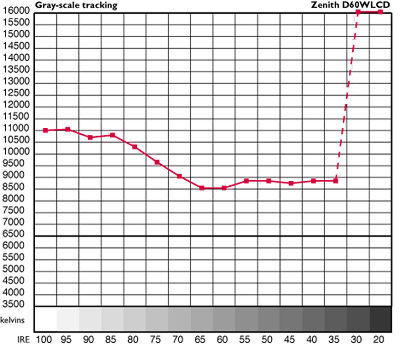Zenith D60WLCD HD-ready rear-projection LCD television Calibration
The Zenith's DVD resolution measured over 500 lines per picture height. Overscan measured 4% top, 6% bottom, 2.5% top, and 4% bottom on both the Wide (anamorphic) and Normal (4:3) settings. The contrast control could be increased to maximum (100) without crushing or clipping the extreme whites, but at a setting of 95 the display put out 62ft-L—good perhaps for a showroom demo or a family room on a sunny day, but much too bright for comfortable viewing in a near-dark room. I backed off to a contrast of 70 (30ft-L) for the remainder of the testing.

As JB has noted, the scaler in the Zenith did a very good job. The ship's railings in Titanic exhibited only some minor and easy-to-ignore jagged-edge artifacts. The pan across the rooftops at the beginning of Star Trek: Insurrection was clean. The Faroudja test DVD showed a quick recognition of 3:2 pulldown and a waving flag largely free of artifacts, though mixed-mode material (film and video combined) was only average rather than good. The Zenith should not generate an immediate need to add a progressive-scan DVD player to your shopping cart.
But there were significant problems. The stability of the black level with varying picture levels (DC restoration) was not good. When I calibrated the black level for proper performance on a PLUGE with gray-scale pattern (Video Essentials, chapter 17-2), then switched to the PLUGE with white bar (17-3), the black level increased to where I could easily see the below-black bar. In other words, as the average picture level increases (gets brighter), so does the black level. Moreover, it was not an instantaneous change; on the PLUGE pattern I could actually see the black level rise (it took about half a second).
The picture also had a slight degree of pincushion distortion, not all that obvious on program material but easy to spot on a crosshatch test pattern. It was most visible from about the mid-right area of the screen to the right edge. I also saw the slight misconvergence JB observed.
You will note that there is only one color-temperature curve in the accompanying figure. That's because Zenith has not designed-in the capability to calibrate this set's gray scale in the field. According to Zenith technical personnel, proper calibration requires a computer, and since this presumably means proprietary software and special test equipment, even our Photo Research PR-650 Spectroradiometer could not help. There are, moreover, no multiple, user-selectable gray-scale options—what you see is what you get. And as you can see from the curve, what you get is much too cool —that is, too blue. Frankly, I don't think the lack of multiple, user-selectable color-temperature choices is a bad thing—if the fixed setting is either correct from the factory or adjustable by a properly qualified technician after delivery. In this case, no after-delivery adjustment is apparently possible and the factory setup is far removed from the D6500 standard.
JB noted the problems with the Zenith's blacks and black-level detail (separate issues from the DC restoration mentioned above). I measured the set's contrast three ways. Full on/full off measured 113, a 100 IRE window/ full off actually measured less at 109, and a 100 IRE window compared with the average level of the black field surrounding it measured 143.
The subjective effect of the set's limited contrast was clearly visible. On Star Trek: Insurrection, all but the brightest scenes were overlaid with a gray haze that worsened as the average picture level got darker. The punch that you get with a good CRT simply was not there. To a certain extent, this is a generic problem with LCDs, but I do recall the Sony Grand Wega KF-60DX100 (not the latest, less expensive Grand Wega KF-60XBR800, not reviewed) evaluated in our July/August 2002 issue as looking somewhat better in this respect, though its measured contrast was actually slightly worse. (The Zenith was measured in a different room with slightly darker, less reflective walls, which may account for the difference.)
Since LCDs appear to have inherent problems reproducing blacks, driving them through the sort of high-gain screen generic to rear-projection sets may simply aggravate the problem. I'm not certain that the problems inherent in using LCDs for rear-projection sets will ever be completely solved, though new technologies such as LCoS (Liquid Crystal on Silicon) and OLED (Organic LEDs) might break the logjam in the future. If you shop for such a set, we strongly recommend you bring along some telling DVDs of your own, particularly those with very dark, low contrast scenes. If it satisfies you, for example, on the darkest scenes from The Lord of the Rings: The Fellowship of the Ring, you're home free. But don't be surprised if it doesn't.—Thomas J. Norton
- Log in or register to post comments




























































